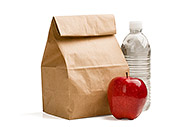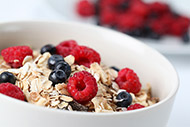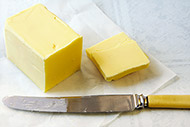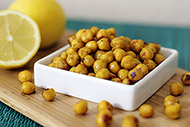
These grocery shopping tips will help you fill your kitchen with nutritious foods.
Produce
- Choose a variety of colors and types of fruits and vegetables. Green leafy vegetables (lettuce, kale), cruciferous vegetables (broccoli, cauliflower, cabbage), root vegetables (carrots, sweet potatoes), berries, and citrus fruits are all nutrient-packed choices.
- Select in-season produce as often as possible for the best flavor.
- Pick up a few fresh herbs. Cilantro, mint, and parsley add flavor and nutrition to your meals.
Breads, Cereals, and Grains
- Choose foods with "100% whole grain" listed on the label or in the ingredient list. Pasta, pita bread, and tortillas all come in great-tasting, whole-grain varieties.
- Try alternative whole grains, such as quinoa, amaranth, millet, and wild rice to add new flavors to your healthy meals.
- Locate a supermarket or health food store that sells cereals and grains in bulk bins. Buying from bulk bins allows you to try smaller amounts of different grains and flours for less money.
Canned and Dry Foods and Oils
- Check the label for serving sizes and sodium content of all canned goods.
- Choose "no salt added" or "low-sodium" products whenever possible.
- You can pick up plenty of protein in this section. Canned and dried beans, dry lentils, and canned tuna are protein-rich choices.
- Choose bottled olive and nut oils over butter and margarine for cooking and flavoring your food. These oils contain heart-healthy, unsaturated fats.
Snack Foods
- Pay attention to serving sizes on food labels. Check the "servings per container" and "serving size amount." At first glance, the calorie content may seem acceptable until you find the serving size is very small.
- Beware of foods labeled "non-fat" or "sugar-free." Sometimes these products contain more calories and are no better than the original version.
- Choose whole grain and baked snacks instead of fried products.
Meats, Poultry, and Fish
- The Mayo Clinic recommends round, chuck, sirloin, and tenderloin for the leanest beef choices. Also look for "Choice" or "Select" beef, which is often lower in fat than “prime” beef. Choose pork from the tenderloin, loin chops, and leg.
- Breast cuts are the leanest choices when it comes to poultry. Check the labels of ground poultry as many options contain both dark and white meat and have as much fat as beef.
- The Monterey Bay Aquarium Seafood Watch program provides suggestions for low-mercury fish choices that are environmentally friendly. These include albacore tuna from the U.S. or British Columbia, farmed rainbow trout, and wild-caught Alaskan salmon.
- Avoid deli and processed meats, which are high in sodium.
Refrigerator
- Buy skim or 1% dairy products rather than 2%, whole milk, or cream. The products with the lower fat percentages contain the same amounts of calcium, vitamins, and minerals as their higher fat counterparts.
- Choose only 100% fruit juices without added sugars.
- Pick plain or low-sugar vanilla yogurts and add your own toppings, such as fresh fruit or a small amount of honey. Compared to flavored yogurts, this approach will help reduce your added sugar intake.
Freezer
- Buy frozen fruits and vegetables without added salt, seasonings, or sugar. When you add flavorings yourself during cooking, you can better control the nutritional content.
- When you crave a frozen treat, look for frozen yogurts, ice milk, and sherbet, which have less saturated fat than ice cream.



 3 Healthy Lunches for Your Work Week
3 Healthy Lunches for Your Work Week
 5 Tips for Stretching Your Budget for Healthy Food
5 Tips for Stretching Your Budget for Healthy Food
 Best Ways to Reduce Added Sugar
Best Ways to Reduce Added Sugar
 Healthy Tips to Lighten Up Picnic Foods
Healthy Tips to Lighten Up Picnic Foods
 Do You Need to Drink Milk?
Do You Need to Drink Milk?
 Tips to Keep Track of Water Intake
Tips to Keep Track of Water Intake
 Butter vs. Margarine: What’s the Best Choice?
Butter vs. Margarine: What’s the Best Choice?
 7 Good Mood Foods
7 Good Mood Foods

 Pinterest
Pinterest RSS Feed
RSS Feed